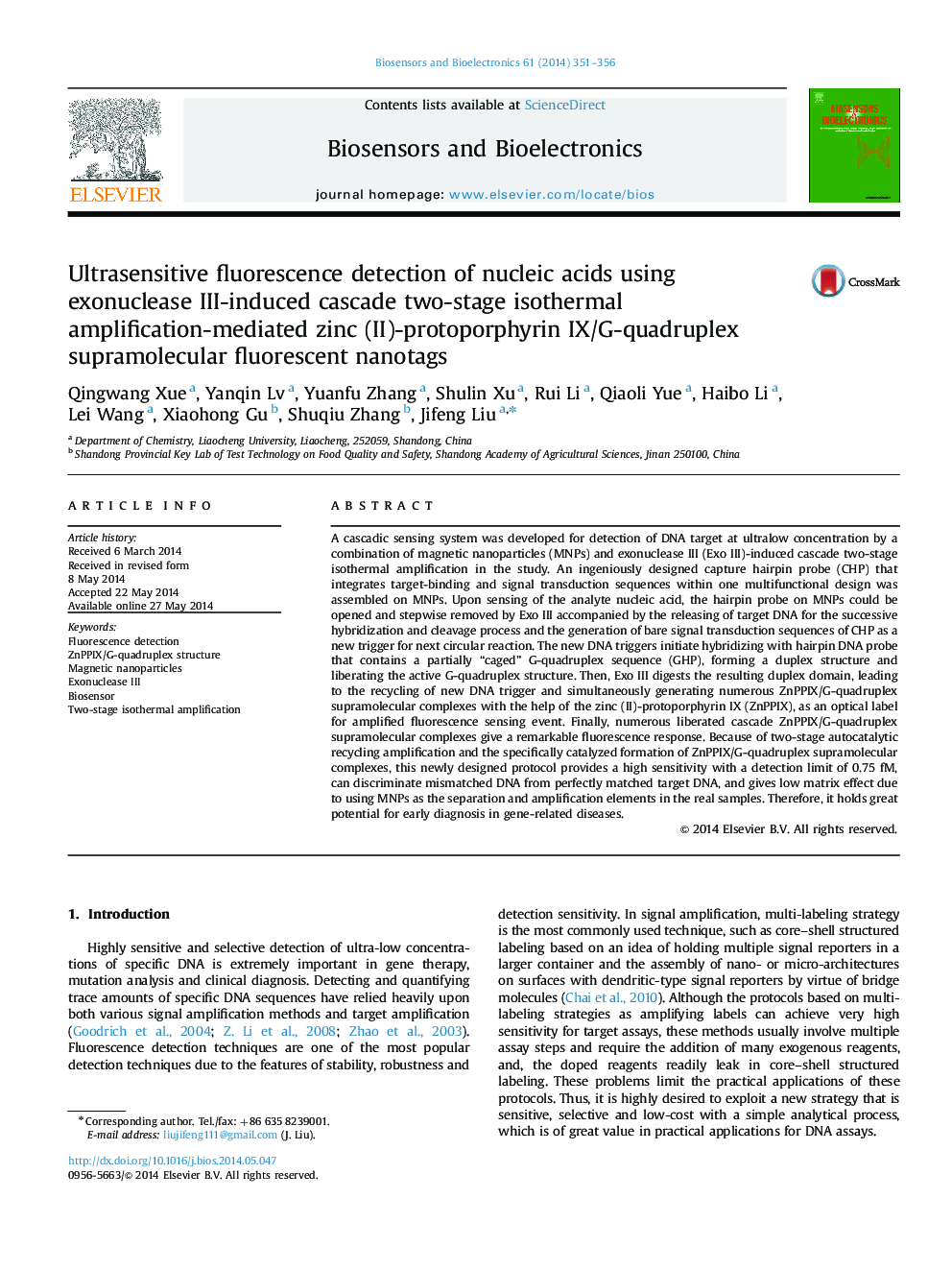| کد مقاله | کد نشریه | سال انتشار | مقاله انگلیسی | نسخه تمام متن |
|---|---|---|---|---|
| 7233209 | 1470970 | 2014 | 6 صفحه PDF | دانلود رایگان |
عنوان انگلیسی مقاله ISI
Ultrasensitive fluorescence detection of nucleic acids using exonuclease III-induced cascade two-stage isothermal amplification-mediated zinc (II)-protoporphyrin IX/G-quadruplex supramolecular fluorescent nanotags
دانلود مقاله + سفارش ترجمه
دانلود مقاله ISI انگلیسی
رایگان برای ایرانیان
کلمات کلیدی
موضوعات مرتبط
مهندسی و علوم پایه
شیمی
شیمی آنالیزی یا شیمی تجزیه
پیش نمایش صفحه اول مقاله

چکیده انگلیسی
A cascadic sensing system was developed for detection of DNA target at ultralow concentration by a combination of magnetic nanoparticles (MNPs) and exonuclease III (Exo III)-induced cascade two-stage isothermal amplification in the study. An ingeniously designed capture hairpin probe (CHP) that integrates target-binding and signal transduction sequences within one multifunctional design was assembled on MNPs. Upon sensing of the analyte nucleic acid, the hairpin probe on MNPs could be opened and stepwise removed by Exo III accompanied by the releasing of target DNA for the successive hybridization and cleavage process and the generation of bare signal transduction sequences of CHP as a new trigger for next circular reaction. The new DNA triggers initiate hybridizing with hairpin DNA probe that contains a partially “caged” G-quadruplex sequence (GHP), forming a duplex structure and liberating the active G-quadruplex structure. Then, Exo III digests the resulting duplex domain, leading to the recycling of new DNA trigger and simultaneously generating numerous ZnPPIX/G-quadruplex supramolecular complexes with the help of the zinc (II)-protoporphyrin IX (ZnPPIX), as an optical label for amplified fluorescence sensing event. Finally, numerous liberated cascade ZnPPIX/G-quadruplex supramolecular complexes give a remarkable fluorescence response. Because of two-stage autocatalytic recycling amplification and the specifically catalyzed formation of ZnPPIX/G-quadruplex supramolecular complexes, this newly designed protocol provides a high sensitivity with a detection limit of 0.75 fM, can discriminate mismatched DNA from perfectly matched target DNA, and gives low matrix effect due to using MNPs as the separation and amplification elements in the real samples. Therefore, it holds great potential for early diagnosis in gene-related diseases.
ناشر
Database: Elsevier - ScienceDirect (ساینس دایرکت)
Journal: Biosensors and Bioelectronics - Volume 61, 15 November 2014, Pages 351-356
Journal: Biosensors and Bioelectronics - Volume 61, 15 November 2014, Pages 351-356
نویسندگان
Qingwang Xue, Yanqin Lv, Yuanfu Zhang, Shulin Xu, Rui Li, Qiaoli Yue, Haibo Li, Lei Wang, Xiaohong Gu, Shuqiu Zhang, Jifeng Liu,